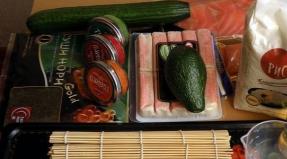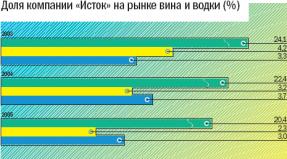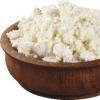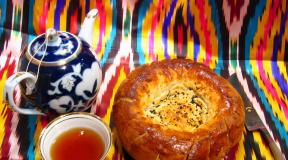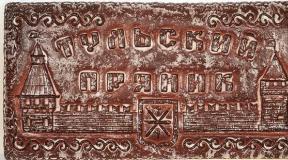Vodka the source of history. Russian varieties of vodka
In the alcohol company "Istok" another appointment: the Frenchman Christophe Nicholas became the general director of the sales division. He must return the lost positions to the "Source". However, other immigrants from Western companies did not succeed in doing this.
It looks like the main owner and president of Istok Taimuraz Bokoev sets up a large-scale personnel experiment. Large-scale both in duration and in the number of hired "stars" and in their brightness. Over the past three years, many well-known top managers of the food and high-tech industries have passed through the offices of the Istok headquarters: Boris Borisov and Alla Gridasova from Motorola, Alexander Pankov from Jamilco, Dmitry Krylov from "Kalina", Igor Udotov from Mars ... Long list. True, none of them lasted long in the company. As they say in competing firms, working under the watchful eye of the authoritarian Taimuraz Bokoev is not the greatest pleasure; in addition, some of the managers simply did not cope with the tasks set by the ambitious shareholder.
In any case, the massive purchase of personnel is only the tip of the iceberg. The company is changing its distribution system, preparing to renew the central brand "Istok" and actively promoting a new product - wine cocktails. Taimuraz Bokoev has good reasons for the development of such a stormy activity. The company is losing its positions in the main areas - vodka and champagne (see chart). Another question is whether the medicine prescribed by Bokoev will cure the illness of his company.
DOSSIER |
Champagne with vodka
Taimuraz Bokoev founded Istok in 1995. The business started with the production of vodka. “Knowledge of export-import operations allowed us from the very beginning to correctly arrange vodka packaging: imported dishes, closures, even a shipping box were ordered abroad,” says Alan Sokolov, development director of the company "Istok". "In 1995, even Kristall supplied vodka in wooden boxes that could be reused." There was, however, a more weighty reason that allowed Istok vodka to sell well: tax breaks, thanks to which Ossetian vodka producers could keep prices lower than those of other Russian producers.
Sokolov does not name the production volumes, but insists that the growth was impressive, and this inspired the creators of Istok to take the next step: in 1997, Taimuraz Bokoev began to rebuild a champagne factory in the vicinity of the vodka production facility. It was built by the German company GEA for eight months. “The Germans first suggested that we do everything in three years. You here measure everything in five-year terms, they said. But we wanted to be in time for the 1998 season, and we had to speed up, ”Sokolov recalls.
We made it in time. The first Istok champagne under the Sovetskoye brand, which was used by all manufacturers at that time, went on sale in mid-1998. “Initially, we experienced certain difficulties in entering the champagne market, where such old-timers as MKShV, Kornet, NZShV, etc. already existed, - says Alan Sokolov. - We had to convince distributors that the new product of Istok is doomed to success. In those days, no one knew about distributor incentive programs and other marketing techniques. Everything was decided at negotiations. "
The production of champagne, a later "child" of Bokoev, is his most successful project today. Since 2001, Istok has been the largest sparkling wine producer in Russia. Market colleagues are sure that Bokoev succeeded in champagne for two reasons. “From the very beginning, Istok had a well-developed federal distribution of vodka, and this helped the company to promote champagne,” says the general director of a large Russian alcohol company, who asked not to be named. “Vodka served as a kind of“ locomotive ”for champagne. Not a single Russian producer of sparkling wine had such a distribution: they all produced the same “Soviet Champagne” and nothing but champagne ”.
According to Herman Klimovsky, Vice-President of the Russian Wine and Vodka Company (RVVK), the secret of Istok's success lies in the Zolotaya Collection brand. “Istok successfully brought it out in 2001, acted competently, did not change positioning and visuals, and this is the result: the brand number one in the category of champagne,” explains Klimovsky.
Having noted the success in the champagne market, Bokoev took the next step. “The production of wine logically followed from the production of champagne,” says Alan Sokolov. “In 1998, we began to produce Monastyrskaya izba (at that time, other manufacturers also produced it. SF). The production volume reached 700 thousand - 1 million bottles per month ”.
However, the wine did not have a chance to repeat the success of vodka and champagne. In 1999, the Cypriot ADB Beverage Industries claimed the rights to the Monastyrskaya izba, which demanded royalties from Russian producers. "Istok" abandoned the "Monastyrskaya izba", having lost almost the entire volume of wine production.
In the same year, Istok began experimenting with its own semi-sweet and dry wines. “The indisputable leadership at that time was held by Moldovan producers with their original bottles in the form of decanters, bunches of grapes, ladies' shoes, etc.,” Sokolov recalls. “Our consumer buys not wine, but a bottle,” familiar importers told me ... Probably because then you can store sunflower oil in it. It should be noted that at that time wine production was not a priority for the company. "
Sales or non-salesNot having time to recover from the loss of the "Monastyrskaya izba", "Istok" faced another problem. In 2002, two of its key distributors - Dilansh and Redmon - began to intersect in retail and unleashed a price war. “We began to prepare a project to change the distribution system,” Sokolov says. “It took a year to analyze possible models. Naturally, we discussed this situation with distributors. Probably even longer than it should have. We offered them to divide the territory, establish a joint sales company, in which they would become co-owners, but, unfortunately, we did not hear a response from them ”.
After much deliberation, Bokoev decided to build his own sales network. “Do not forget that our colleagues in the market are mainly engaged in one category of alcoholic beverages: either vodka, or champagne, or wine, or cocktails, or cognac,” argues Alan Sokolov. several categories of goods. But try to explain to the distributor about all these "accents" ... "
In the fall of 2003, Bokoev created the Istok Trading company with headquarters in Moscow, and in February 2004, the first dealer conference was held, where a new sales system was announced. In 11 cities with a population of one million there are representative offices of Istok Trading, each of which is responsible for sales on its territory. Almost each of the 150 partner distributors employs source trade agents (totaling 500 people) who are responsible for selling products directly to stores. “In order to reduce the costs associated with opening branches, it is easier to bring employees into the distributor’s staff,” says Alan Sokolov.
General Director of the company "Russian recipe and Co" Mikhail Shcherbakov I am convinced that a model similar to the one developed by Istok can be effective: “To pay off your own distribution company, you need a full portfolio of services for a retail network and an assortment of brands. Today, in the increasingly competitive market, distributors cannot be involved in the sale and promotion of specific brands. To pay attention to its brands, a manufacturing company needs to have its own focused sales team in each city or region. "
Bearish perks
Istok started a distribution reform at the right time. In 2003, Ossetian spirits producers lost their tax benefits. As a result, Istok's products on the store shelves have risen in price by 15–20 rubles at once. However, Alan Sokolov argues that the rise in price is only partly due to the abolition of benefits. According to him, "Istok" deliberately raised prices, as demand has shifted towards more expensive vodka for several years. Whatever the reason, the price hike resulted in a 50 percent drop in production.
“Tax breaks allowed the company to actively invest in the development of the brand, - says the head of a large alcohol company. - When the company lost the benefits, it should have affected the margin (and, accordingly, marketing budgets), as well as the final price on the shelf. The former consumer - a buyer with low incomes - could no longer pay a new price for vodka, and the new consumers were not yet ready for this. "
According to Herman Klimovsky, the fall of Istok has deeper roots. “I think the Istok vodka project has no prospects at all,” says Mr. Klimovsky. “The company has changed its concept too often. Istok is a strong brand, but when there are 8-10 visualization options for one brand on the shelf, the consumer starts to get confused. The company initially worked closely with Moscow, but did not want to invest in time to promote it in retail chains, but in vain. If in 2004 chain retail accounted for 20% of sales, now it is more than 50%. As a result, the company missed two key vodka markets - Moscow and St. Petersburg. It is absent in many of the key distribution channels in both capitals. And in the regions, another Ossetian producer, Galakta with Poltina vodka, is actively advancing on the position of Istok.
According to the data of Business Analytica, cited by Klimovsky, in May 2006 the overall level of distribution of all Istok vodka brands was 23%, and the maximum level of representation of one brand - Istok Original Lux - was only 13%.
Elena Polevaya, partner of the headhunting company Rushant, sees the reasons for the company's failures in a specific personnel policy: the operation “Hello, we are looking for talents”, in her opinion, was a wrong idea. “A star team is, in principle, an expensive pleasure. To bring the stars together, it is necessary to offer a compensation package that is more profitable than in transnational corporations, and to invest in a team building. Do not forget also about a solid car fleet of foreign cars and "white" salaries, - says Polevaya. - Of course, each member of the team was a professional of the highest class, but the team did not work out. In addition, Ossetian vodka is not Coca-Cola or Mars bars; it has its own production, marketing and logistics nuances. Finally, Western managers are used to working with Western budgets, which are much more generous than Russian ones. "
 |
No matter what the market says, Taimuraz Bokoev, with his characteristic tenacity, continues to adhere to the chosen line. Expat appointment Christophe Nicholas CEO of Istok Trading - a completely logical continuation of the personnel course.
Distribution reform is also far from complete. It looks like Istok has decided to take control of the entire supply chain from the conveyor to the store shelf. The first to come under control was Moscow chain retail, where German Klimovsky points out its weak positions. Now the source drinks are delivered to Moscow chains by the Soyuzpostav company. While it is part of the "Source of Trading", however, it will soon be separated into an independent division. Perhaps, over time, distribution will become a separate business of Istok: Alan Sokolov does not exclude that in the future similar Soyuzpostavas will appear in other cities. And they will be selling not only Istok products. And not just alcohol.
Now "Istok" is in a rather difficult position. However, the company was able to restore the volume of wine production under its own brands to the level of 1 million bottles per month and is actively correcting mistakes with the Moscow retail. In addition, at the beginning of next year, Istok vodka in a new look will appear on store shelves. The indicators really give the management reason to hope for the best: according to Sokolov, this summer "Istok" sold twice as much vodka as in the summer of 2005. So Taimuraz Bokoev still has a chance to prove that Western-minded top management can be useful even in such a specific industry as Russian alcohol.
January 31 marks the 154th anniversary of the "birthday" of vodka. On this day in 1865, Dmitry Mendeleev defended his doctoral dissertation on the topic "On the combination of alcohol with water."
Vodka is a strong alcoholic drink, a mixture of rectified (food) ethyl alcohol with water. To prepare vodka, a mixture of alcohol and water (sorting) is passed through activated carbon, then filtered.
By adding infusions of herbs, seeds, roots and spices to vodka, various infusions are prepared.
Other types of vodka are obtained by distilling fermented sweet liquids.
Types of vodka
Ordinary vodka in Russia is a 40% solution of alcohol purified from fusel oil in water. Cleaning is carried out hot in rectification plants or cold - in vodka. Alcohol here is diluted with water (to a strength of 40-45%) and filtered through a series of vats filled with charcoal (best of all birch), which absorbs fusel oil (traces remain). The best vodka is made from rectified alcohol.
Special vodka is prepared by dissolving various essential oils and aromatic substances in ordinary vodka or alcohol.
To obtain fruit vodka, ripe berries are crushed, the juice is squeezed out, sweetened and forced to ferment (adding yeast). The fermented wort is distilled.
The history of the emergence of vodka
The prototype of vodka was made in the 11th century by the Persian physician Ar-Razi, who was the first to isolate ethanol (ethyl alcohol) by distillation. The Koran prohibits Muslims from drinking any alcoholic beverages, so the Arabs used this liquid (vodka) exclusively for medicinal purposes, as well as for the preparation of perfumes.
In Europe, the first distillation of an alcohol-containing liquid was done by the Italian alchemist monk Valentius. The alchemists of Provence (France) adapted the alembic invented by the Arabs for converting grape must into alcohol.
In Russia, vodka appeared at the end of the XIV century. In 1386, the Genoese embassy brought the first vodka (aqua vitae - "living water") to Moscow and presented it to Prince Dmitry Donskoy. In Europe, all modern spirits were born from "aqua vita": brandy, cognac, whiskey, schnapps and Russian vodka. The volatile liquid obtained as a result of the distillation of the fermented wort was perceived as a concentrate, the "spirit" of wine (in Latin spiritus vini), hence the modern name of this substance in many languages, including in Russian - "alcohol".
In 1429, "aqua vita" was again brought to Moscow by foreigners, this time as a universal medicine. At the court of Prince Vasily II Vasilyevich, the liquid was apparently appreciated, however, due to its strength, they preferred to dilute it with water. It is likely that the idea of diluting alcohol, which, in essence, was "aqua vita", was the impetus for the production of Russian vodka, but, of course, from grain.
The method of vodka production became presumably known in Russia in the second half of the 15th century and was probably due to the appearance of grain surpluses that required quick processing.
Already at the beginning of the 16th century, "burning wine" was taken not to Russia, but from it. This was the first experience of Russian vodka export, which was later destined to conquer the world.
The word "vodka" itself appeared in Russia in the 17th-18th centuries and, most likely, is derived from "water". At the same time, in the past, the terms wine, tavern (as they called vodka made illegally, under the conditions of the state monopoly introduced in the 18th century), inn wine, smoked wine, burning wine, burnt wine, bitter wine, etc. were also used to denote vodka.
With the development and improvement of vodka production in Russia, remarkable results have been achieved in terms of purification and taste characteristics of the drink.
The dynasties of Russian "vodka kings" and breeders began in the Peter the Great's era. In 1716, the first emperor of All Russia offered the noble and merchant classes the exclusive right to engage in distillation on their lands.
In the middle of the 18th century, the production of vodka in Russia, along with state-owned factories, was occupied by noble landowners, owners of estates scattered across the country. Empress Catherine II, who patronized the nobility, who granted him many different benefits, made distilling an exclusive privilege of the nobles. A significant part of the vodka was produced in the manors of the landowners, and the quality of the drink was raised to boundless heights. Manufacturers sought to achieve a high degree of purification of vodka, used for this natural animal proteins - milk and egg white. In the 18th century, Russian "home" vodkas enjoyed an excellent reputation, produced by the Kurakin princes, the Sheremetev counts, the Rumyantsev counts, and others.
At the end of the 19th century, for the first time in Russian history, a state standard for vodka was introduced. This was largely facilitated by the research of famous chemists Nikolai Zelinsky and Dmitry Mendeleev - members of the commission on the introduction of the vodka monopoly. The merit of the latter is that he developed the composition of vodka, which was supposed to correspond to 40 ° in strength. "Mendeleevsky" version of vodka in 1894 was patented in Russia as "Moscow special" (later - "Special").
In Russian history, the state (tsarist) monopoly on the production and sale of vodka was repeatedly introduced. For example, in 1533 the first "tsar's tavern" was opened in Moscow, and the entire trade in vodka became the prerogative of the tsarist administration, in 1819 Alexander I reintroduced the state monopoly, which existed until 1828, from 1894 a state monopoly began to be periodically introduced in Russia, strictly observed in 1906-1913.
The state monopoly on vodka existed throughout the entire period of Soviet power (formally - from 1923), while the technology of production of the drink was improved, and its quality was at an invariably high level. In 1992, by the decree of Russian President Boris Yeltsin, the monopoly was abolished, which entailed a number of negative consequences (financial, medical, moral, and others). Already in 1993, a new decree was signed, returning the monopoly, but the state was unable to strictly control its implementation.
The history of prohibitive measures against vodka is noteworthy. So, during the Russo-Japanese War, there was a ban on the trade of vodka in some provinces of the empire. "Prohibition" was introduced in Russia at the very beginning of the First World War, continuing to operate even after the establishment of Soviet power (only in 1923 the sale of liqueurs with a strength of no more than 20 ° was allowed, in 1924 the permissible strength was increased to 30 °, in 1928 the restrictions were lifted , in 1986, under Mikhail Gorbachev, an unprecedented campaign was launched to combat drunkenness, in fact, the use of alcohol, which was not crowned with success and entailed the massive destruction of vineyards, the production of low-quality "underground" alcoholic beverages, the growth of drug addiction, etc.) ...
As an element of everyday culture, vodka took a specific place in the history of Russian life, marked by such verbal symbols - "signs" as "mentikov dime", "katenka", "kerenki", "monopolka", "rykovka", "andropovka", "smirnovka "(by the name of one of the largest domestic producers of vodka), etc., and has also become an invariable solid payment unit (" bottle of vodka "), especially in rural areas. Vodka is often perceived as a national symbol of Russia, on a par with samovar, balalaika, matryoshka, caviar. Remaining until the end of the 20th century one of the most widespread Russian national drinks, vodka served as the basis for a huge number of tinctures, the preparation of which has become a special branch of home production in Russia.
Since January 1, 2010, in order to combat the illegal trade in alcohol in the country, Russia has introduced a minimum price for a 0.5 liter bottle of vodka in the amount of 89 rubles. The corresponding order was signed by the Federal Service for the Regulation of the Alcohol Market (Rosalkogolregulirovanie). If the bottle is of a different volume, the minimum price will be calculated in proportion to the capacity.
Thus, now the consumer will be able to make an informed choice between a legal and an illegal manufacturer. According to experts, taking into account the excise tax on alcohol planned for 2010, the cost of a bottle, VAT and minimum markups in retail and wholesale, the price of a bottle of vodka does not really exceed 89 rubles.
The material was prepared on the basis of information from RIA Novosti and open sources
It is made from "Extra" alcohol, specially prepared water, with the addition of citric acid, bonifier AMO 97, sugar syrup.Fortress 40%.
Bogorodskaya
It entered the top ten brands of vodka and alcoholic beverages on the Russian market over a ten-year period (1994-2005). Special vodka "Bogorodskaya classic" - Strictness, solidity and loyalty to traditions. Impeccable, primordially Russian taste. Traditional, emphasized "vodka" aroma. Honey and infusion of pine nuts give the joy of communication with native nature. For adherents of the classic lifestyle.Ingredients: rectified alcohol of the highest purity, corrected drinking water, natural honey, infusion of pine nuts, vanillin.
Gzhelka
It is prepared from rectified ethyl alcohol "Lux"; drinking specially prepared purified water; Sahara; citric acid to soften the taste.Fortress 40%.
Zavalinka
The composition includes rectified ethyl alcohol "Extra", specially prepared drinking water, sugar, acidity regulator sodium bicarbonate E500.Golden ring
The most glorious cities of the Russian land, rich in traditions and unique ancient beauty, united in the Golden Ring of Russia. Also in the vodka "Zolotoe Koltso" all the best that Russian nature, history and technology have created: delicious specially purified natural water; high-grade alcohol of the "Lux" class, a traditional recipe and a little food additives for a unique taste and clean, delicate aroma.The composition includes rectified ethyl alcohol "Lux", specially prepared drinking water, acidity regulators: sodium bicarbonate E500, food acetic acid E260. Has a pure vodka aroma, exceptionally mild taste.
Strength: 40% vol.
Ivan Kalita
Crystal clear and transparent, perfect in form. Classic pronounced harmonious vodka aroma, giving "confidence" in the original origin of the drink.The composition includes rectified ethyl alcohol "Lux", drinking specially prepared purified water, sugar, acidity regulator citric acid E330. Has a pure vodka aroma and mild taste.
Strength: 40%
Volumes: 0.5l / 0.7l
Source
Istok Originalnaya Lux vodkas are based on Lux alcohol and mountain spring water. The drinks are bottled in branded frosted bottles with a cork with a special dispenser. This series includes vodkas: "Original Lux" - vodka prepared according to the classic technology of Russian vodkas (the simplest and at the same time the most popular vodka of the company; it includes the most common and widely used components in vodka formulations - acetic acid and glycerin ) "Blackcurrant Lux" (with "Blackcurrant" flavor), "Lemon Lux" (with "Lemon" flavor and natural honey), "Pepper Lux" and "Strong Lux".Vodka "Istok Premium" is produced by specialists using a unique recipe on the most modern European equipment. The peculiarity of Istok Premium vodka is truly pure water, alive, spring water, which is specially delivered to the plant from natural springs located at the foot of Mount Zilgahokh. Alpine glaciers are the basis for the purity of spring water. Vodka "Istok Premium" contains honey with royal jelly and extract of grape ridges, which protect the body from harmful environmental factors.
Parliament
"Premium" class vodka made from grain alcohol "Lux" using a unique technology - milk purification of vodka, which gives the drink extraordinary softness and pure vodka aroma. Vodka "Parliament" has a pleasant aftertaste.For the purification of vodka, the Parliament also uses egg white. The purification technology consists in the fact that the prepared proteins are introduced into a water-alcohol solution in a certain proportion, which attract harmful micro-impurities, after which the product is purified from the proteins themselves.
Vodka Parliament goes through a complex filtration system to neutralize fusel oils and esters, which make the drink unpleasant and even harmful. Before creating a blend with grain alcohol, the water is also purified, saturated with the necessary minerals. In the process of making vodka, the Parliament undergoes a 12-stage purification.
Today, the market offers consumers the following assortment - "Blackcurrant Parliament", "Classic Parliament", "Mandarin Parliament", "International Parliament".
Ambassadorial
Extraordinary and plenipotentiary representative of the glorious galaxy of legendary Russian vodkas. It is prepared according to a special technology on rectified grain-conditioned alcohol and delicious drinking water. The unique processing with dry milk gives the vodka incomparable transparency and crystal shine, neutralizes the sharp aroma.The composition includes rectified ethyl alcohol "Extra", specially prepared drinking water. Vodka is prepared using a special technology, using skimmed milk powder.
Has a pure vodka aroma and mild taste. Strength: 40% vol.
Volumes: 0.1L / 0.25 / 0.5L / 0.7L / 1.0L / 1.75L
Premier
It is made from grain alcohol of the "Lux" class on the basis of specially filtered and softened water from an artesian well with a depth of 650 meters. The production uses a triple purification system, filtration on a carbon battery of activated charcoal made from birches grown for at least 25 years. When spilled, the inner surface of the bottle and lid is rinsed with the vodka itself.Available in three types: Premier Red, Premier Blue and Premier Silver (with silver ions).
Putinka
Possesses a truly Russian soul. The classic combination of the excellent "Lux" alcohol and the purest specially prepared water emphasize the purity of sensations. It has a lot of advantages: under the softness and tenderness of the taste there is a strong character, and under the delicate aroma of vodka there is an atmosphere of peace of mind and confidence.The composition includes rectified ethyl alcohol "Lux", specially prepared drinking water, sugar, infusion of crispbread, complex food additive "LAR-SU". Has a pure vodka aroma and mild taste.
Strength: 40% vol.
Volumes: 0.25L / 0.5L / 0.7L / 0.75L / 1.0L
Wheat
The composition includes rectified ethyl alcohol "Extra" from food raw materials, corrected drinking water. Produced since 1980.Strength: 40% vol.
Product format: 0.25L; 0.5l; 1.75L
Rye
The rye Lux vodka is based on a classic Russian recipe: making a drink from selected rye, and alcoholized infusions of bread. These traditionally Russian vodkas have been retaining and increasing their popularity for several centuries. It is distinguished by the brightness of taste, purity, pleasant aroma of freshly baked bread.Russian size
The composition includes natural artesian water, grain alcohol "Extra", rye infusion, sugar, drinking soda and ascorbic acid. Positioned in the middle price segment.Russian standard
It is believed that this drink fully complies with the standard of Russian vodka of the highest quality, approved by the tsarist government commission headed by D.I. Mendeleev in 1894 (hence the number 1894 on the label). Produced by "Russian Standard" since 1999. This vodka contains alcohol of the "Lux" class, purified drinking water, infusion of oatmeal and wheat bread.Fireworks, Golden-headed!
The composition includes corrected drinking water, rectified ethyl alcohol of the highest purification, natural honey, flavor identical to natural "Honey ASG-906".Old Moscow
In modern and fast-paced Moscow, there are hidden corners where life has retained its ancient rhythm and style. Vodka "Staraya Moskva" - for those cases when it is so pleasant to get away from the hustle and bustle of business and leisurely rest, as in the good old days. Excellent rectified alcohol "Lux" and the purest specially prepared and softened drinking water emphasize the purity of sensations. Perfectly matched proportions of nutritional supplements create a warm, deep and delicate taste that gives a sense of peace and joy. After a hot day in modern rhythms, plunge into the patriarchal home atmosphere with a misted pile of cold "Old Moscow".The composition includes rectified ethyl alcohol "Lux", drinking specially prepared purified water, acidity regulator malic acid E296. Has a characteristic vodka aroma and mild taste.
Strength: 40% vol.
Volumes: 0.1L / 0.25L / 0.5L / 0.7L / 1.0L / 1.75L
Stolnaya
The Stolnaya trademark is one of the first and most famous brands of the OST-ALCO Chernogolovsky alcoholic beverage plant. Vodka and tinctures of TM "Stolnaya" have been produced since 1998. Stolnaya special vodka is made according to an old Russian recipe, restored by the Chernogolov plant together with leading Russian specialists. For its production, water from artesian wells, alcohol from selected varieties of Russian wheat and aromatic alcohol of viburnum are used. The drink has a mild vodka taste and aroma.The composition includes corrected drinking water, rectified ethyl alcohol "Extra" from food raw materials, sugar, aromatic viburnum alcohol, glycerin, vanillin, identical to natural flavor.
Flagship
The composition includes ethyl alcohol "Lux", corrected drinking water, fructose, vitamin premix "GSVit 5", sodium bicarbonate, succinic acid, extract of lemongrass seeds.Fortress 40%
White gold
It is produced on the most modern equipment, which includes a jewelry-accurate cleaning process. The design of the bottle matches the precious content and reliably protects against counterfeiting.The composition includes rectified ethyl alcohol "Lux" corrected drinking water, infusion of oat flakes and wheat without yeast bread, sugar.
White leopard
Strong, with a slight softness on the palate. It is made from ethyl alcohol and the purest drinking water. Due to the traditional technology of vodka preparation "Snow Leopard" has a pleasant, clean vodka aroma. Ingredients: corrected drinking water, rectified ethyl alcohol "Lux", sugar, infusion of buckwheat.Strength: 40%
Festive
The best is prepared for the holiday in Russia. Vodka "Prazdnichnaya" was created to make your festive fun shine with all facets. It contains natural grain alcohol "Extra", specially prepared delicious drinking water and sugar syrup create a rich, soft and rich taste, suitable both for large celebrations and for family celebrations. The tenderness of vodka and its delicate aroma create a light, joyful mood. And thanks to the crystal purity and transparency, the holiday lasts a long time and leaves only pleasant memories.Ingredients: rectified ethyl alcohol "Extra", specially prepared drinking water, sugar, acidity regulator, citric acid E330.
Has a pure vodka aroma and mild taste.
Strength: 40% vol.
Volumes: 0.1L / 0.25 / 0.5L / 0.7L / 1.0L
Slavic
The infusion of birch buds prepared according to a special recipe gives this vodka a delicate aroma of spring freshness and purity. Birch buds for Slavyanskaya Myagkaya vodka are harvested in early spring, at the beginning of swelling, must be dried in the cold, after which an alcoholic infusion is prepared within five days. With this technology, vodka acquires freshness, tenderness and softness of taste. Vodka "Slavyanskaya Myagkaya" was awarded the Gold Medal of the Ministry of Agriculture "For High Quality" during the 5th International Forum "Beverage Industry" in November 2005.Once the largest producer of Russian sparkling wine - the Istok plant - is resuming its work. The structures of billionaire Vasily Anisimov could have taken part in resolving the conflict with creditors, according to RBC sources
Photo: Vladimir Astapkovich / RIA Novosti
The fact that the once well-known alcohol factory "Istok" in Beslan (North Ossetia) will resume its work in the coming months, was told by a source on the alcohol market and confirmed by the head of the republic's department for state regulation of production and circulation of alcoholic and alcohol-containing products Batraz Khidirov ... According to the official, the launch of production is scheduled for August.
Istok was founded in 1995 and produced, in particular, sparkling (Golden Collection, Russian) and wines (Old Custom, Tender Night). According to Vadim Drobiz, director of the Center for Research on Federal and Regional Alcohol Markets (TsIFRRA), in 2008 Istok was the largest champagne producer in Russia - its share of the sparkling wine market was about 20%. In 2009, production had to be stopped due to the company's tax arrears and problems with servicing loans at Sberbank, VTB and UniCredit Bank. The total debt of the company to banks was about 4.5 billion rubles, in addition, the debt was personally owned by the beneficiary of Istok Teimuraz Bokoev. Since 2012, the bankruptcy procedure for Istok began, bankruptcy proceedings were introduced.
New at the "Origins"
The republican authorities tried to restore the work of the enterprise all these years. In April 2016, the acting head of the republic, Vyacheslav Bitarov, promised that Istok would resume work by the end of the year. “There were investors who were ready to agree with creditors to pay debts, because of which the plant became bankrupt,” he said in an interview with TASS. Who exactly showed interest in the enterprise, Bitarov did not say.
Khidirov also does not name the investors, only notes that "for the period 2015-2016, the company was bought out by new shareholders." The point is that during the bankruptcy, the creditor banks of Istok (Sberbank and UniCredit Bank) received the assets of the enterprise, which were subsequently bought from them by new investors, explained Aslanbek Gutnov, CEO of Novy Istok JSC (the JSC was created as part of the restructuring debt of the enterprise).
According to a RBC source close to the management of the new enterprise, the assets were purchased without a significant discount.
The debt to VTB has not yet been paid off, a bank representative told RBC. “Now“ Istok ”is undergoing bankruptcy proceedings at the stage of selling the collateral. President of Istok Group of Companies Taimuraz Bokoev, who is a guarantor for loans, also did not pay off his debt to VTB Bank, "the bank explained to RBC. As Gutnov says, "everything has been settled with VTB by 90%." “There are non-essential assets that will be taken away by [VTB] in the second place. They do not affect the launch process today. [Finally] VTB assets will be transferred this month, "added the interlocutor of RBC, specifying that the launch of the plant is scheduled for June 2017.
According to Khidirov, preparations are underway for licensing an enterprise with a new name, Istok ZVSh LLC. “Strong alcoholic beverages, vodka, alcoholic beverages, wine drinks, wine, champagne (sparkling) wines are planned for release under the Istok ZVSh brand,” he said. The next stage will be licensing of another enterprise - LLC "Istok-spirt" for the production of alcohol. “The enterprise also has auxiliary production, which is planned to be launched in 2018 - a glass painting shop, a printing house, a cardboard shop,” Khidirov added.
These two companies, as well as Winemakers of the North Caucasus, according to SPARK-Interfax, were registered recently, in March 2017, at the historical address of the plant in Beslan. All companies have a common owner - Istok JSC, founded by Vasily and Elena Moiseev. Vasily Moiseev is the head of LLC “Legal Firm“ Nikolaev and Partners ”. The website of this company says that its clients include BTA Bank, Nadymstroygazdobycha, Moscow Jewelry Factory, etc. Vasily Moiseev confirmed to RBC that he created Istok JSC and was its founder, but “it has been sold for a long time”. To whom - he did not specify.
According to two RBC sources in the alcohol market, managers of the alcohol distributor Status Group took part in the negotiations between Istok and banks (in the portfolio of the company vodka Putinka, Drova, Vysota and others), the market has long been associated with the owner Caolco by Vasily Anisimov. According to one of the interlocutors, the management of the "Status Group" oversaw the process of restoring the plant in terms of organizing sales and assortment. "The main task that they have been solving for a long time is the settlement of the situation around the assets of the enterprise, which were at the banks," - notes the source of RBC.
Aslanbek Gutnov denies the participation of "Status-group" in the restoration of the enterprise. “I can say that there are several ultimate beneficiaries. These are Ossetian and Russian businessmen. Who exactly is a commercial secret, ”added Gutnov. Vasily Anisimov did not respond to RBC's request.
Restoration of the "Source"
“You need to be a very rich and desperate person to start a plant now,” says Vadim Drobiz. - Since 2012, the champagne market has shrunk by a third, with wine carbonated drinks taking part of the market. The market is very dense - it is difficult to squeeze into it, ”the expert warns.
The term "wine carbonated drinks" appeared in Russian legislation in 2012, just at the time the bankruptcy proceedings began at Istok. Like Drobiz earlier, in fact, these drinks have become "legalized counterfeit", which is gradually gaining an increasing market share. So, if in 2015 160 million liters of sparkling wines were produced in Russia, in 2016 this figure will drop to 150 million liters. For comparison: in 2011, the production of sparkling wine (champagne) was 230 million liters.
Leonid Popovich, President of the Union of Winegrowers and Winemakers of Russia, notes that the consumer has forgotten Istok's products, and it will be very difficult for him to take at least a noticeable share. “The company will have to start from scratch. In fact, this is not a restart - it is a new venture entering the market. Very significant investments and efforts will be required for placement in networks, for marketing, ”Popovich said, finding it difficult to name a possible amount. Entering the champagne market with declining sales is “doubly difficult,” he added.
The official representative of the Russian Wine House "Abrau-Dyurso" Daria Domostroeva noted that the "folk" and middle-price segments of sparkling wines have shown negative dynamics over the past five years. “Everything will depend on the segment in which the Source will work after the restart. If the company focuses on the production of sparkling wine drinks, it will be able to compete in price with other participants in this segment, ”she said. Among the risks for the company, she also names a significant increase in excise taxes on sparkling wines from imported raw materials and a potential ban on imported wine materials. “At one time, Istok worked on imported wine material,” recalls Domostroeva.
What is vodka, from what and how it is made, what is the difference between vodka-distillate and vodka made from rectified alcohol.
Substitution of terms as a historical factor
Vodka is a water-alcohol solution considered to be the Russian national alcoholic drink. Vodka is a clear liquid with the smell and taste of alcohol, and consists of only two components: rectified ethyl alcohol and water.
Vodka, along with matryoshka, balalaika and tame bear, has become part of the national Russian flavor for foreigners, and like everything familiar, it raises no questions. And in vain. Over the past two centuries, vodka has undergone such outlandish changes that people discussing it will probably talk about something of their own. The 40-degree transparent liquid familiar to everyone (at least from store counters), even from different manufacturers, is not at all the same thing. And if you look at its history, instead of clarity, only new questions will be added.
Only the bear is missing
A similar story happened with tobacco. The explosive growth of oncological diseases occurred after, in the first half of the 20th century, traditional tobacco products were replaced by cigarettes, the contents of which were at first a waste of tobacco production, and subsequently synthesized chemically from cellulose and harsh chemicals. For a long time this has nothing to do with tobacco, in principle, but it is tobacco that is accused and prohibited of diseases.
But let's move on to the history of vodka.
"Bread wine" in Russia in the 18-19 centuries
Until the 19th century, almost all strong alcohol obtained by distillation (distillation) and subsequent infusion was called "vodka". Yes, initially vodka, like brandy, cognac, gin, whiskey, grappa, rum, tequila, was obtained by distillation, and grain crops were used for this. The main raw material for the production of first "hot bread wine" and then vodka was rye as the main Russian grain crop. There is little sugar in rye, so the rye was first germinated to obtain malt, in which there is much more sugar. Mash was made from malt, and vodka was made from mash by distillation.

The level of consumption of alcoholic beverages in Russia by the beginning of the 20th century was moderate against the general European background. Vodka accounted for 93% of all alcohol consumed
Distillation from potatoes and beets was not popular, since the alcoholic drink from them was of much poorer quality. It was not possible to remove fusel oils in the desired volume from the potato drive, the taste and smell of such a distillation was much worse than "bread wine" made from rye, barley and wheat.
By the end of the 18th century, bread vodkas obtained by distilling "hot bread wine" became the hallmark of the Russian alcohol market. Wayne vodkas from "grape hot wine" and "fruit and berry hot wine" were also produced in Russia, but the priorities in their production belonged to other countries. In Russia, however, such vodkas were made from imported raw materials, be it "hot wine" or ready-made French vodka, which was used to make liqueurs.
Distillate vodka
This is what the process of making "bread wine" was like.
- The raw material was used to obtain mash, a low-alcohol drink with a low alcohol content (up to 11 °).
- Braga was poured into a distiller, in which the liquid was heated and began to evaporate. The vapors were removed through the branch pipe, cooled and condensed.
- The resulting drink with a high alcohol content retains the taste and smell of the raw materials from which it was produced. Unwanted impurities were removed with charcoal, milk or eggs.
Speaking about the quality of strong alcohol, many use the word "booze" in a clearly negative connotation. This is an erroneous judgment based on a misunderstanding of the issue. Fusel oils add flavor and aroma to the drink. The bouquet of expensive cognacs and whiskey is created not by flavors, but by natural organoleptic properties, the very "booze" from which the noses of "connoisseurs" wrinkle, and aging in oak barrels. However, the disgusting smell of moonshine is also created by fusel oils. Everything depends on the composition and the ability to get rid of unnecessary things.
You may be interested in What you need to know about cognac

Industrial distillation of alcohol using 19th century technology
For distilled spirits, the combination of taste, smell and purity is critical. Harmful and unpleasant fusel oils are removed, leaving those that correspond to the original raw material:
- Grapes (in brandy, cognac and grappa)
- Malt (in whiskey)
- Apples (in calvados)
"Erofeichi", ratafias and tinctures
Until the second half of the 19th century, “erofeichi” and ratafii (“liqueurs of the highest kindness”, “sweet vodka”) were prepared from the 80 ° alcohol (obtained by the fifth run) by infusion of fruits, berries and herbs in an alcoholic distillate. For additional purification of ratafias from unwanted fusel oils, karluk (“fish glue”) was used, whose cost was a hundred times higher than the cost of sturgeon caviar. It is clear that only very rich people could afford such drinks.
In addition, purified distillates were used in medicine for the production of tinctures - herbal tinctures.
You may be interested in Pepper liqueur on vodka or moonshine "Thor's Hammer"
Rectified alcohol vodka
With the development of the chemical industry and technology in the 19th century, it became possible to produce rectified alcohol. Unlike distillate alcohol, rectified alcohol was chemically purer and much cheaper. It was possible to produce such alcohol from almost anything: potatoes, beets, sawdust (hydrolysis alcohol). The rectification method produced alcohol with a strength of up to 96 °, the content of fusel oils that impart taste and smell was extremely reduced, and the volume and speed of production using this technology were simply incomparable with production using distillation technology. And it was precisely economic reasons that led to the fact that distillate vodka was completely replaced by rectified vodka.

Alcohol rectification using 19th century technology
The consequences were dire.
- The culture of drinking has completely changed. Distillate vodka was a food drink that had its own taste and smell. Rectified vodka itself has no taste, it is drunk not for the sake of taste, but for the sake of alcohol. Rectified vodka is drunkenness for the sake of drunkenness, and you should not deceive yourself.
- Cheap vodka became one of the economic foundations of the Russian Empire, and then the USSR, and an instrument of control from a political point of view. “From 1767 to 1863, the wine farm provided 33% of state revenues, exceeding receipts from direct taxes - the poll tax and quitrent from state peasants. In the 1850s. this figure has grown to almost 38%. " (Goryushkina N. E, 2011).
- The most important consequence: vodka from rectified alcohol displaced from the market not only all traditional types of Russian “bread wine”, but also beer and mead brewing was destroyed: “The Russian people owe to the ransom system (1765−1863) beer and honey brewing was reduced to naught, and people were doomed to consume mainly vodka. As a result, by the beginning of the XX century. the share of vodka in the structure of consumed beverages was 93% ”. (Zaigraev G.G., 2009). From now on, only a water-alcohol solution was called vodka, which did not have any food and taste value.
Vodka has become so firmly in the everyday life of the population that any fluctuations in the selling price, and even more so - the introduction of "dry laws" led to severe social consequences. But this is already a topic for another material.
Myths about Russian vodka
By itself, the word "vodka" in the 19th century was more a tax term than the common name for a certain alcoholic beverage. You can prove as much as you like that vodka was invented in Russia, but in fact the technology was not invented here. The use of a water-alcohol mixture that has no nutritional value has become a Russian specificity. Pure vodka is drunk for the sole purpose of being drunk. The name ("vodka"), raw materials (rye) and fortress (40%) became a Russian brand. But here too there are many questions, to each of which there are several answers. This confusion is beneficial to many, and primarily, of course, to manufacturers.
Vodka as a Russian brand
In the late 70s of the 20th century, the Soviet Union was almost banned from selling vodka under the name "vodka". Soviet trade organizations such as Soyuzplodimport were very surprised and did not believe the very opportunity to take away the brand “Russian vodka”: “How is it, this is our primordial, kondovo-sitnoye ?!”. That's how. It turned out that there weren't even any patents for the brand. The argument “Everyone knows that vodka was invented in Russia” did not work.

It turned out that even in V. Dahl's dictionary there is no independent word "vodka", it is mentioned there only in the context of "wine" (which, in fact, was in his time vodka). Until 1936, the name "table wine" was used, although from 1895 it was a completely different product, which received its official name: vodka.
The brand was defended thanks to the scientific research of William Pokhlebkin, who was able to prove the Russian priority in the creation of the term and technology for the production of vodka. But objectively, his argumentation has a number of gaps and exaggerations: yes, bread wine obtained by distillation was mentioned in historical documents a century earlier than Polish vodka. But we were also talking about a different product, and the differences are fundamental.
Polish vodka was made from potatoes and beet sugar, was cheap and of low quality. It was practically not cleaned, and the disgusting smell and taste were masked with herbs. Russian vodka was made from grain and refined with coal, milk and eggs. The product was more expensive, but the quality was incomparable to Polish vodka.
It is likely that attempts to take away the vodka brand will continue in the future. Wait and see.
Russian vodka and raw materials for its preparation
As we have already discussed above, there was no unique technology for the production of strong alcohol in Russia and in the Russian Empire. Likewise, hard liquor was produced all over the world. And if we talk about some unique Russian know-how, then these include raw materials for the production of vodka and the technology of purification of the run.

Receiving vodka by the lower ranks of the Russian destroyer. Early 20th century
Russian bread wine was made from rye malt, using the same technology used for whiskey production. So why is there such a difference in taste, smell and color?
One of the reasons is the cleaning technology. Whiskey is poured into oak sherry barrels, in which they are aged for three years or more. Oak wood absorbs fusel oils, while saturating the whiskey with aromatic and tannins. It is clear that due to the complete absence of winemaking in Russia, this technology was closed here. The purification was carried out by precipitating fusel oils with milk, eggs, and dwarf.
You may be interested in Technology for the preparation of tinctures, liqueurs and liqueurs
Since the change of technology and the beginning of the production of vodka from rectified alcohol, the uniqueness of the Russian recipe for making vodka has gone. Russian could be considered "bread wine". Alas, there is nothing Russian and traditional in the water-alcohol mixture.
When a producer of rectified vodka writes on a bottle “Purified with milk” (or silver, or something else), he is misleading the buyer. There is nothing to purify in the rectified and there is no need. Purification of rectified vodka with milk is like sunflower oil without cholesterol, which is not present in any sunflower oil, has not been and cannot be by definition.
Did Mendeleev invent vodka
This is perhaps one of the most enduring and stupid legends. Information about cooperation with Mendeleev was once launched by vodka industrialist Pyotr Arsenievich Smirnov. For the 19th century, Smirnov was simply an advanced marketer. Having expanded the production of vodka, he sent the hired people to taverns, where they demanded to sell them "Smirnovka". The innkeepers drew conclusions and bought Smirnov's vodka, business went on.

Petr Arsenievich Smirnov
Smirnov also knew how to work with a reputation. The rumor that Mendeleev is related to his vodka is an example of this. DI Mendeleev in his youth collaborated with one of the most famous vodka manufacturers Vasily Kokorev. But even while working with Kokorev, Mendeleev did not deal with the issues of vodka production. Kokorev hired Mendeleev as a consultant in the field of oil production and transportation. No more.
Mendeleev is credited with the "ideal ratio" of water and alcohol in vodka. But even this absolutely teetotal D.I. Mendeleev did not do it. The standardization of the strength of vodka was carried out under Peter I, and at that time it was 38-39 degrees. To check the quality and prevent attempts to dilute the bread wine, it was heated and set on fire. Half of a high-quality product burned out, and since the combination of alcohol with water has its own characteristics, the alcohol content in it was the same 38-39 degrees. How so?
If you mix a liter of alcohol and a liter of water, the resulting volume will be less than two liters. Because the result is not a mixture of water and alcohol, but an alcohol hydrate. The alcohol hydrate molecule is much smaller than the separated water and alcohol molecules. And one more feature: there are many such alcohol hydrates, and their properties are also different. Mendeleev in his work "On the combination of alcohol with water" proved that the greatest compression corresponds to a solution with a weight content of alcohol of 46%. With this ratio, the volume of the solution is minimal.
So where did the 40-degree vodka come from? The Russian Minister of Finance M.Kh. suggested rounding off the figure 38.5 to 40. Reitern. It was easier to calculate tax deductions that way. 40 degrees does not determine either the quality or the "drinkability" of vodka, the figure is arbitrary and simply makes life easier for officials.
Distilling vodka at home
Why not return to the traditional methods of producing strong alcohol and vodkas, including the ferrying method? If the peasants could cope with this, why the townspeople could not cope with it?
There are several reasons for this. Here are the main ones.
- Distillation is a complex and laborious process. In addition to special equipment, you need a lot of experience. It is not easy to qualitatively purify alcohol from fusel oils, aldehydes and ethers. After all, it was not in vain that the ancestors used karluk for this, and not only coal and milk. Poisoning with "stool" is a common phenomenon. There is no need to risk your own and other people's health, if you can not risk it.
- The traditional "bread wine" was made from rye. Actually, even today elite brands of rectified vodkas are made from Alfa alcohol, the raw material for which is rye. Cheaper varieties of vodkas are made with an admixture of potato and beet alcohol. It is simply unprofitable to create a distillery at home (for example, in a city apartment), and most "moonshiners" distill mash made from anything other than grain crops.
What is the difference between cheap vodka and expensive brands? In fact, nothing. Pure ethyl alcohol, from which vodka is made, does not contain any impurities that affect the taste and smell of the drink. You pay for bottle design and marketing.
Homemade vodka tinctures allow you to get a higher quality alcohol than when trying to recreate the whole process completely, from mash to ferrying and infusion.
As a conclusion
The vodka obtained by the rectification method has no nutritional value. She has two appointments.
- Traditional. In Russian cuisine, vodka plays the same role as ginger in Japanese cuisine: it can be used to remove the aftertaste of the previous dish at once, completely concentrating on the next bite. We do not use subtle spices, we do not have a special philosophy of food, gourmand is not peculiar to us. Well, it just so happened. Good vodka is able to set off and enhance the taste of simple and rather rough food from the point of view of foreigners: boiled potatoes, onions, pickled cucumbers and bacon. And vodka copes with this function perfectly.
- Vodka is a powerful adaptogen. The production of ethyl alcohol is part of the normal physiology of the human body. Decrease in ethanol naturally produced by the body - apathy, depression, bad mood. And with age, the ability to produce ethanol naturally declines. Chronic alcoholics do not have this option at all. In reasonable controlled doses, alcohol can act as a medicine. The trouble is that the line is narrow, and it is very easy to cross it imperceptibly for oneself.
The main thing we can do to restore a healthy drinking culture is to restore nutritional value to alcohol. Yes, alcohol from rectified alcohol is much more affordable than distillates. Yes, it has no taste or smell of its own. But why not improve its properties by traditional methods - by infusing fruits, vegetables and herbs on vodka? It is these recipes that we try to select and test.
On the site vypeymenya. рф you will find recipes for vodka infusions at home, without the use of complex technological equipment and easily reproducible without specific skills. We see alcohol not just as "mood drinks", but as complete foods that increase appetite, aid digestion, and can enhance and emphasize the taste of food.

